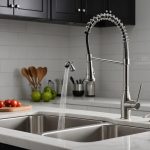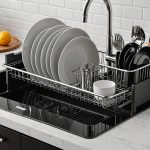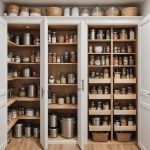Importance of Maintaining Ceramic Kitchen Tiles
Caring for ceramic kitchen tiles is crucial to preserving their aesthetic appeal in UK homes, where they are prized for both style and function. A well-maintained kitchen floor not only enhances the room’s appearance but also adds to the overall ambiance. Regular ceramic tile maintenance ensures that these tiles continue to impress with their glossy finish and vibrant colours, offering lasting beauty to any kitchen space.
Beyond aesthetics, routine kitchen tiles care significantly impacts their durability. High-quality ceramic tiles are known for their robust nature, but without proper upkeep, their lifespan can diminish. By routinely cleaning and applying sealant when needed, homeowners can prevent issues like cracks, stains, and fading. This care process is a simple yet effective way to ensure tile longevity, allowing them to withstand daily wear and tear.
Also read : Creative pantry organization tips: space-savvy solutions for slim kitchens in the uk
Neglecting tile care can lead to several problems, including hygiene and safety concerns. Dirt and grime can accumulate in the grout lines, creating an ideal environment for harmful bacteria. Furthermore, damaged tiles can pose physical risks, such as sharp edges or uneven surfaces, possibly leading to accidents. Prioritising regular maintenance can prevent these issues, ensuring a clean, safe, and stunning kitchen environment.
Essential Cleaning Techniques for Ceramic Tiles
When it comes to ensuring the longevity and aesthetic appeal of your ceramic tiles, mastering cleaning ceramic tiles is crucial.
In the same genre : Mastering the art of uk kitchen design: essential tips for seamless entertaining and lively gatherings
Daily Cleaning Routines
Establishing a daily cleaning habit helps maintain the shine and integrity of your tiles. Utilize a soft-bristle broom or a microfiber dust mop to remove loose dirt, as accumulated debris can scratch the surface. Follow up with a damp mop using a gentle cleaning solution. Always avoid anything too abrasive to prevent damaging the glaze.
Weekly Deep Cleaning Strategies
For tile cleaning methods that dig deeper, dedicate time each week to tackle the grout and any lingering stains. A soft brush and a mixture of baking soda and water can work wonders on grout lines. After applying, let the mixture sit for a bit before gently scrubbing. Ensure to rinse thoroughly.
Recommended Cleaning Solutions
Having the right products is key to effective tile maintenance. Look for pH-neutral cleaners, which are gentle yet effective. In the UK, products like Astonish Tile Cleaner have gained popularity for their eco-friendly composition. Also, consider Method’s Daily Granite Cleaner, which, despite its name, works well on tiles too.
By adhering to these cleaning techniques, your ceramic tiles will remain vibrant and robust, ready to handle the demands of daily life.
Sealing Ceramic Tiles for Longevity
Sealing ceramic tiles is essential for maintaining their durability and appearance over time. Without proper sealing, tiles are susceptible to stains and wear, which can compromise their aesthetic and functional qualities.
Importance of Tile Sealing
The primary purpose of tile sealing is to create a protective barrier against moisture, stains, and wear. This step is crucial in areas like kitchens and bathrooms, where exposure to water and spills is frequent. By sealing ceramic tiles, you not only enhance their lifespan but also retain the tiles’ natural beauty and resist damage from everyday use.
How to Seal Ceramic Tiles Effectively
- Clean Thoroughly: Before applying any sealant, ensure the tiles are clean and dry. Use a pH-neutral cleaner to remove any dirt or grime.
- Select a Suitable Sealant: Choose a sealant appropriate for your ceramic tiles and the environment. In the UK, consider sealants designed to handle wet and cold climates.
- Apply Evenly: Spread the sealant evenly across the tile surface with a brush or roller, ensuring all areas are covered.
- Allow to Dry: Let the sealant dry according to the manufacturer’s instructions, usually around 24 hours.
- Repeat as Needed: For optimal protection, repeat sealing every 1-2 years, depending on the tile’s exposure to harsh conditions.
Using the right products and following a regular sealing schedule will ensure your ceramic tiles remain beautiful and functional for many years.
Preventing Damage to Ceramic Kitchen Tiles
When it comes to preventing tile damage, understanding the common culprits is crucial. In UK kitchens, everyday activities can take a toll on ceramic tiles.
Common Causes of Tile Damage
Ceramic tiles often suffer from chips and cracks due to heavy impacts, such as dropping pots or pans. Shoes with hard soles and the movement of heavy furniture can also cause stress, leading to damage. Water spills left unattended are harmful, particularly if they seep into the grout.
Tips for Avoiding Chips and Cracks
Avoiding damage starts with awareness. Using kitchen rugs or mats in high-traffic areas can reduce stress on tiles. Be cautious when moving heavy kitchenware, and use protective pads under furniture. Regularly inspect tiles for early signs of damage, which are easier to fix initially.
Strategies for Protecting Grout Lines
Grout lines, often overlooked, require meticulous care. Kitchen tile protection involves sealing grout to prevent moisture accumulation, which can lead to staining and instability. Regular cleaning with mild pH-balanced solutions can prolong grout life. Consider using a grout pen to maintain appearances and prevent tile damage.
Dealing with Stains and Difficult Spots
When it comes to kitchen tiles, stain removal is crucial for maintaining both aesthetics and hygiene. Common types of stains include food spills, grease marks, and soap scum. Food spills, particularly those involving acidic ingredients like tomato sauce and vinegar, can leave stubborn marks on tiles. Meanwhile, grease tends to accumulate near cooking areas, creating sticky, hard-to-clean spots. Ceramic tile care is essential in addressing these issues effectively.
Prompt action is key to managing stains effectively. Delaying cleaning efforts can cause stains to set, complicating removal and possibly damaging the tile surface. When handling tough stains, such as coffee spills or red wine marks, a mix of water and vinegar or baking soda paste can perform wonders. It’s vital to apply gentle but firm pressure to avoid scratching the tile finish during tile spot treatment.
For ceramic tiles, specific cleaning agents tailored for ceramic tile care can be more effective. These cleaners are designed to tackle grime and stains without harming the tile. Regular maintenance prevents the buildup of dirt and grime, keeping tiles vibrant and extending their lifespan.
Adopting these strategies will not only keep your kitchen tiles spotless and inviting but also ensure they remain in pristine condition for years to come.
Local Considerations in the UK
Understanding how tile maintenance varies across the UK is crucial due to diverse environmental conditions.
Effects of Hard Water on Tile Care
Hard water is a common challenge in many UK regions, significantly impacting tile care. Hard water deposits can leave unsightly stains and cause grout deterioration. Homeowners in hard water areas must frequently clean to prevent build-up on their tiles. A popular solution is using descaling agents designed for UK-specific tile maintenance. These products effectively remove lime and mineral deposits without damaging tile surfaces.
Climate Factors Influencing Tile Maintenance
The UK climate also plays a vital role in tile care. Areas with high humidity may experience more rapid growth of mould and mildew on tiles, especially in poorly ventilated spaces like bathrooms. Regular cleaning and the use of fungicidal cleaners can mitigate these issues. Coastal regions face additional challenges with salt air corrosion, requiring special maintenance approaches.
Regional Product Recommendations
Different regions demand distinct cleaning solutions based on climate impacts. In areas with hard water, choose sealants and cleaners specifically formulated to combat mineral deposits. For humid areas, products with mould-resistant properties are recommended. Brands like Lithofin and HG offer ranges suitable for varied UK conditions, catering to both homeowners and professionals.
Common Mistakes to Avoid
When it comes to tile maintenance, homeowners often fall into several pitfalls that can lead to long-term damage and increased costs. One of the most common cleaning errors is using harsh chemicals, which can strip tiles of their protective coating, leading to fading and damage over time. To counter this, one should opt for mild, pH-neutral cleaners that preserve the tile’s finish.
A frequent maintenance mistake is neglecting regular cleaning. Dirt and grime can settle in the grout lines, causing discolouration and weakening the tile’s structure. A consistent cleaning routine helps prevent buildup and maintains the tiles’ appearance and integrity.
Incorrectly applying sealant or skipping the sealing process altogether is another typical oversight. Sealants protect tiles from moisture and stains, extending their lifespan. Homeowners should ensure that tiles are sealed periodically and that the correct type of sealant is used for their specific tile material.
Neglecting proper tile maintenance techniques can result in costly repairs and replacements. By being aware of these common errors and implementing corrective measures, homeowners can significantly improve their tile care routines and enjoy durable, aesthetically pleasing surfaces for years to come. Pursuing informed and regular maintenance practices mitigates long-term degradation and preserves the tiles effectively.



















